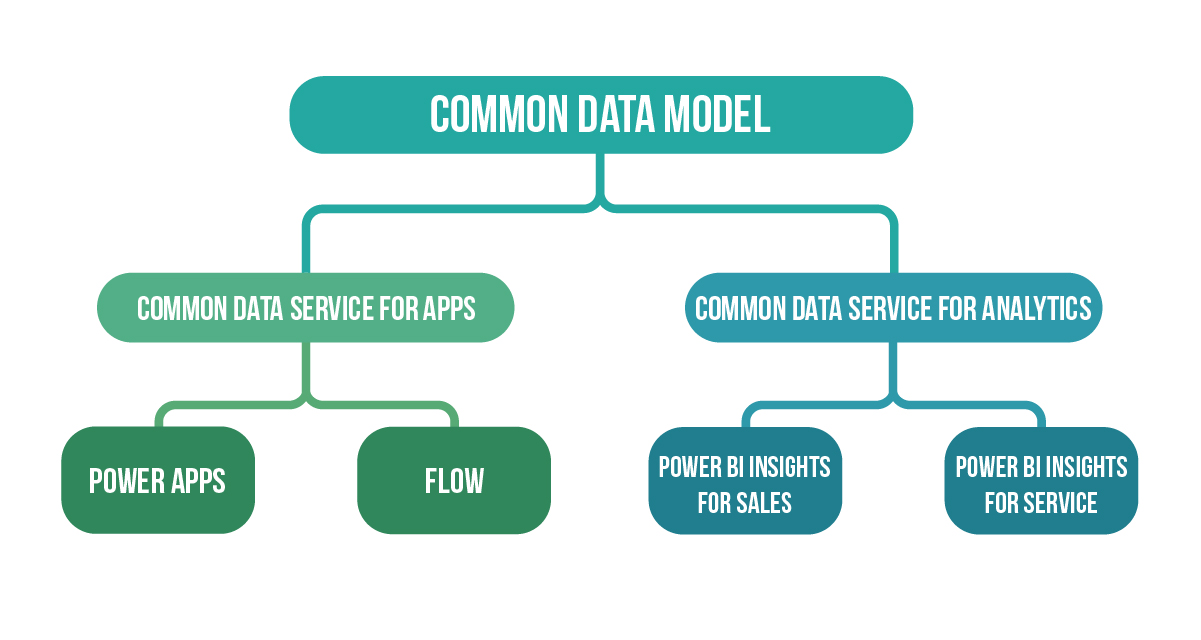With the Microsoft Business Applications, spring 2018 release. Microsoft is unleashing a wave of innovation across the entire product line with numerous new features in three core areas: new business applications; new intelligent capabilities infused throughout; and transformational new application platform competence
As part of the innovations and improvements rolled out across the company’s business applications division, users of platforms such as Dynamics 365, Office 365, and Power BI can soon witness changes that will make it easier to share information between apps, collect useful insights from their data, and build custom apps to support their business processes.
In this article, we will take a closer look at what is CDS V2.0 and how Dynamics users can benefit from it
What is Common Data Service V2.0?
“The Common Data Service is the Microsoft Azure-based business application platform that enables you to easily build and extend applications with their business data. The Common Data Service does the heavy lifting of bringing together your data from across the Dynamics 365 family of services so you can focus on building and delivering the apps, insights and process automation that matter to you and your customers with Power Apps, Power BI, and Microsoft Flow.”
Early 2018, Microsoft rebranded its Common data service as the Common data service for apps. It allows the users to quickly integrate programs, build new custom applications and create automated workflows. With the easy access of data by apps across a company’s digital stable, Microsoft couldn’t have positioned Dynamics 365 as an intelligent, cloud-first platform
By bringing together data from Dynamics 365 apps, Office 365 and other third-party sources, enterprises are able to make sense of data generated by disparate programs, giving them a more complete picture of their business.
The Common Data Model allows apps to integrate and share data with each other without the need for extensive, custom integration by providing a centralized point where systems can come together and connect, and bridging the gap between repositories of information once divided by a digital language barrier.
The CDM not only allows Microsoft business applications to communicate with each other but also with third-party apps and services.
Benefits For Dynamics 365 Users
Future growth across all industries, and the organization and business models of entire industries themselves will be driven in large part by applying digital technologies to more intelligently engage customers, reimagine products and services, transform operations and empower employees.
On combining information from the full suite of Dynamics 365 apps, and authorizing data to be shared with other platforms, the CDS v2.0 equip Dynamics 365 users with numerous advantages:
Centralization of data
The new Common data service provides users with a stable platform in which they can store their collective Dynamics 365 data so that their apps can communicate with, and even learn from, each other. Earlier when companies were using both ERP and CRM apps from Dynamics family, the data from each platform was isolated.
“CDS helps to facilitate the movement and synchronization of data between complementary applications, for example transferring customers and contacts from Dynamics 365 Sales to Finance and Operations,” explains Ham.
“Now that Microsoft Dynamics 365 suite of specialized products are connected by the Common Data Service, it ensures each individual application is connected to the same source of data.”
Addition of new applications to Dynamics 365 is made easier to cater for requirements as your company grows. This enables the seamless and secure transfer of data between applications for a much simpler and more reliable user experience
Build Apps and Workflows without coding
CDS v2.0 is built on Common Data Model, which provides the data-based infrastructure on which Power Apps and Flows can be built.
It’s an easy drag and drop based platform which help users without any coding experience to get the most out of their business. Thus leaving room for development and automation.
Integration with 3rd party services
CDS V2.0 allows connecting 3rd party apps like Salesforce, Buffer, MailChimp, Facebook, Google Drive, Trello, and Zendesk with Microsoft flow. This enables Dynamics 365 users to create workflows across all of their cloud service.
Deeper Analytics
The CDS for Analytics provides users with a data lake which is directly integrated into Power BI, making it easier for users to get a complete overview of their business using data pulled from a variety of sources.
Data stored in the Common Data Service for Apps integrates easily and automatically with the Common Data Service for Analytics for customers who use both services. You can start from enterprise and transactional data you already own (such as leads, campaign information, and previous customer purchases) and combine it with data from other sources (such as weblogs or product telemetry) to get a unified picture.
Learn more about how your organization can implement service innovation from cutting-edge AI solutions designed for the most complex enterprise scenarios to modular apps that let you tackle discrete business transformation processes one at a time with Dynamics 365. Contact one of our experts today to get a free consultation on how you can implement Dynamics 365 in your organization and find the perfect solution for your business. Write to us at info@sysfore.com or give us a call at +91 (80) 4110 5555



